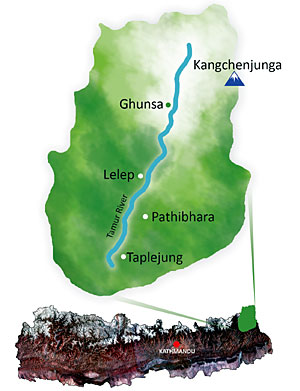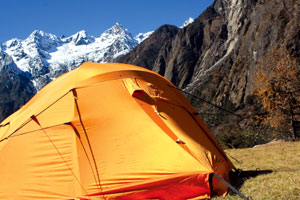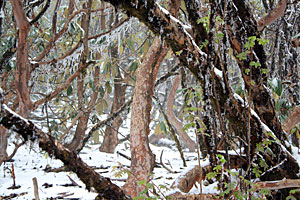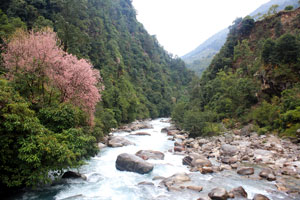 |
 PICS: ANURAG ACHARYA |
Kangchenjunga, the third highest point in the world, is more a mountain range than a peak. Stretching east to west across nearly 25 kilometers from Sikkim to Nepal, Kangchenjunga looks as if a slice of the planet has risen to pierce the stratosphere.
The mountain dominates the northern horizon, most famously from Darjeeling, and the best access is from Sikkim. However, it is from the western side in Nepal that the approach to the mountain offers the most adventurous and dramatic treks.
The narrow, sparsely populated valleys on the upper reaches of the wild Tamur River have been the refuge of only the most driven holy men, naturalists and mountain climbers. The foot of Kangchenjunga is the least-visited among 16 protected areas in Nepal. Its location on the north-eastern corner of the country gives the region the highest annual rainfall, and hence the richest biodiversity. The pristine coniferous forests, high meadows and wetlands are the most biologically rich areas of the country inhabited by many amphibians, birds, plants and animals found nowhere else. Many of the mammals found here are endangered: the snow leopard, the red panda, or musk deer.
 |
"This place is radically different from anything and everything you've seen in your life", says Canadian Glenn F. Miller who was camping in Ghunsa on his way to the base camp. The author of 'Dreaming Kathmandu' admitted that the place inspired him to write.
 |
'One of the most beautiful places on earth' sounds like a clich�, but walking along a ridge with the hulk of Jannu towering over us, it is clear there is no other way to describe this trail.
Perhaps Kangchenjunga has remained remote and pristine because it is so inaccessible. The nearest airfield at Suketar is unreliable, and although the road has reached Taplejung it is an arduous 16 hours from Kathmandu via Bhadrapur before you even start the three week trek.
 |
Says Stevens: "If we can integrate all major trekking routes along the east-west Himalayan stretch and encourage tourists to explore new destinations, it will increase the span of their stay or bring them back to Nepal creating more jobs and bringing in money."
The GHT Development Program, promoted by the government in partnership with SNV Netherlands is working closely with stakeholders in the tourism industry, NGOs and host communities to develop best practices in tourism, contributing to local economy through sustainable tourism.
Road to nowhere
This is the dilemma of tourism everywhere: do you improve access so more people can visit, or do you deliberately limit infrastructure to preserve an area's natural beauty?
In 2010, over half a million tourists visited Nepal. Their average span of stay increased from 11.3 to 12.6 days but the number of trekkers and mountaineers decreased by half. One reason was the expansion of road networks along main trekking routes.
The undisturbed trails of Kangchenjunga can help to revive trekking numbers. But this needs investment in airports and basic infrastructure. Here in Kangchenjunga, it also means repairing trails and lodges damaged by the earthquake in September.


